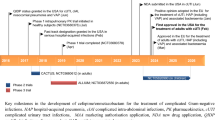Abstract
In Italy fluoroquinolones (FQs) are extensively prescribed in empirical therapy of uncomplicated urinary tract infection (UTI) despite recommendations in national guidelines and widespread antibiotic resistance in community. To survey the dissemination of plasmid-mediated quinolone resistance in a peak area of FQs consumption, E. coli strains from 154 community and 41 local hospital patients were collected; low level ciprofloxacin resistance qnrA, qnrB, qnrS, and aac(6)′-Ib-cr genes were screened by PCR and patterns of transferable resistances were determined. Clinical ciprofloxacin resistance in hospital doubled community value, while overall rates of FQ resistance genes were similar (31.6% and 27.8%). Prevalence of aac(6′)-Ib-cr gene was 11% in outpatients (21%, inpatients) and risk of harbouring this variant was significantly associated with gentamicin resistance; linkage to ceftazidime resistance was significant (P = 0.001) and six out of eight strains produced CTX-M-15 and TEM-1 beta lactamases. In transconjugants, the unique pattern ampicillin/kanamycin-gentamicin/ ESBL + was associated with aac(6′)-Ib-cr gene presence and with an increase of ciprofloxacin MIC value. Data highlight the need to monitor the resistance risk factors in the local community to provide clinicians with well-grounded guidelines for UTI therapy.
Similar content being viewed by others
References
Gupta K, Hooton TH, Naber KG, Bjorn W, Colgan R, Miller LG et al (2011) Executive summary: International clinical practice guidelines for the treatment of acute uncomplicated cystitis and pyelonephritis in women: A 2010 update by the Infectious Diseases Society of America and the European Society for Microbiology and Infectious Diseases. Clin Infect Dis 5:103–120
Karlowsky JA, Hoban DJ, Decorby MR, Laing NM, Zhanel GG (2006) Fluoroquinolone-resistant urinary isolates of Escherichia coli from outpatients are frequently multidrug resistant: results from the North American Urinary Tract Infection Collaborative Alliance-Quinolone Resistance study. Antimicrob Agents Chemother 50:2251–2254
Strahilevitz J, Jacoby GA, Hooper DC, Robicsek A (2009) Plasmid-mediated quinolone resistance: a multifaceted threat. Clin Microbiol Rev 22:664–689
Warburg WG, Korem M, Robicsek A, Engelstein D, Moses AE, Block C et al (2009) Changes in aac(6′)-Ib-cr prevalence and fluoroquinolone resistance in nosocomial isolates of Escherichia coli collected from 1991 through 2005. Antimicrob Agents Chemother 53:1268–1270
Galatti L, Sessa A, Mazzaglia G, Pecchioli S, Rossi A, Cricelli C et al (2006) Antibiotic prescribing for acute and recurrent cystitis in primary care: a 4 year descriptive study. J Antimicrob Chemother 57:551–556
Schito GC, Naber KG, Botto H, Palou J, Mazzei T, Gualco L et al (2009) The ARESC study: an international survey on the antimicrobial resistance of pathogens involved in uncomplicated urinary tract infections. Int J Antimicrob Agents 34:407–413
Piatti G, Mannini A, Balistreri M, Schito AM (2008) Virulence factors in urinary Escherichia coli strains: Phylogenetic background and quinolone and fluoroquinolone resistance. J Clin Microbiol 46:480–487
Clinical and Laboratory Standards Institute (2005) Performance standards for antimicrobial susceptibility testing; fifteenth informational supplement M100-S15. CLSI, Wayne, PA
Pallecchi L, Bartoloni A, Fiorelli C, Mantella A, Di Maggio T, Gamboa H, Gotuzzo E, Kronvall G, Paradisi F, Rossolini GM (2007) Rapid dissemination and diversity of CTX-M extended-spectrum beta-lactamase genes in commensal Escherichia coli isolates from healthy children from low-resource settings in Latin America. Antimicrob Agents Chemother 51:2720–2725
Park CH, Robicsek A, Jacoby GA, Sahm DF, Hooper DC (2006) Prevalence in the United States of aac(6′)-Ib-cr encoding a ciprofloxacin-modifying enzyme. Antimicrob Agents Chemother 50:3953–3955
Carattoli A, García-Fernández A, Varesi P, Fortini D, Gerardi S, Penni A, Mancini C, Giordano A (2008) Molecular epidemiology of Escherichia coli producing extended-spectrum beta-lactamases isolated in Rome, Italy. J Clin Microbiol 46:103–108
Gagliotti C, Mazzetti I, Moro ML (2009) Comparison of sales and reimbursement data regarding outpatient antibiotic use in a northern Italian region. Pharmacoepidemiol Drug Saf 18:1115–1118
Metlay JP, Strom BL, Asch DA (2003) Prior antimicrobial drug exposure: a risk factor for trimethoprim–sulfamethoxazole-resistant urinary tract infections. J Antimicrob Chemother 51:963–970
Amin AK, Wareham DW (2009) Plasmid-mediated quinolone resistance genes in Enterobacteriaceae isolates associated with community and nosocomial urinary tract infection in East London, UK. Int J Antimicrob Agents 34:490–491
Acknowledgement
We would like to thank Prof. Gian Maria Rossolini for the scientific support; his precious and useful suggestions improved the conceiving of our study.
Funding
None.
Competing interests
None declared.
Ethical approval
Not required.
Author information
Authors and Affiliations
Corresponding author
Rights and permissions
About this article
Cite this article
Longhi, C., Conte, M.P., Marazzato, M. et al. Plasmid-mediated fluoroquinolone resistance determinants in Escherichia coli from community uncomplicated urinary tract infection in an area of high prevalence of quinolone resistance. Eur J Clin Microbiol Infect Dis 31, 1917–1921 (2012). https://doi.org/10.1007/s10096-011-1521-6
Received:
Accepted:
Published:
Issue Date:
DOI: https://doi.org/10.1007/s10096-011-1521-6




